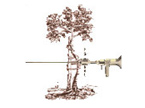Pediatric Orthopedics is the study and treatment of growing bones, joints and muscles. Pediatric Orthopedists use many techniques, including observation of growth, physical therapy, braces and splints, and occasionally surgery to treat various conditions such as congenital deformities, injuries, neurological disorders, and scoliosis. These conditions are discussed in general below, with links being added to more specific information as time goes by.
Variations of Normal Anatomy & Congenital Deformities
Frequently, young children and adolescents have conditions that are variations of normal anatomy. These include children who toe-in or toe-out excessively, children with “bad posture” such as round-back or sway-back, and children who are delayed in learning to walk or have unusual patterns of walking such as “toe walking”. Often these problems are variations of normal developmental patterns and do not represent an underlying disease.
In such cases, the child’s growth and patterns of walking, posture, and muscular development need to be observed over time in order to establish whether the child’s growth pattern will return to normal spontaneously.
A small percentage of children have birth defects. These include spinal problems such as spina bifida, limb deformities such as clubfoot, or other congentital defects such as extra fingers or toes. Pediatric Orthopedists frequently follow these children through years of growth and into adult life.
Childhood Injuries
Children often break bones. With these fractures there is often a potential injury to the growth centers of the skeleton. Pediatric Orthopedists evaluate the child for potential growth problems that may happen after the injury heals and treat growth disturbance if it occurs. Appropriate treatment of fractures, sprains and dislocations can ensure minimal disturbance of function and a quick return to normal childhood growth and activity.
Pediatric Sports Injuries
Pediatric Sports Medicine is an important part of health care. Children who engage in activities like soccer, karate, and skateboarding may have acute injuries such as broken bones, sprains, and dislocations. Many times chronic stress injuries occur, such as fractures, tendinitis, and apophysitis. Examples are “Little Leaguer’s Elbow”, Osgood-Schlatter’s disease of the knee, and Sever’s Disease of the foot. Treatment of these injuries is usually simple and seldom requires surgery.
Neurological Disease
Many patients seen by Pediatric Orthopedists have neurological disorders such as cerebral palsy, spina bifida, or the family of diseases known as dystrophies. Most of these disorders result in muscle imbalance and deformity in the areas involved, such as drop foot, scoliosis, or paralytic clubfoot.
Children with cerebral palsy or spina bifida frequently require bracing or surgery to improve their ability to function to their greatest potential.
Scoliosis and Kyphosis
These conditions are deformities of the spinal column and may occur at any time before or after birth, but are more frequent during the adolescent growth spurt. Scoliosis is curvature of the spine seen in about 5% of teenage girls. Kyphosis is an excessive round-back deformity common in teenagers.


